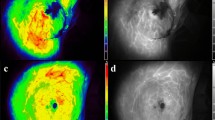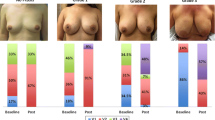Abstract
Purpose
The skin and/or nipple-sparing approach has become an oncologically sound and desirable choice for women choosing mastectomy. Indocyanine green (ICG) perfusion imaging has been shown to reduce ischemic complications in mastectomy skin flaps. Immediate reconstruction requires a well-vascularized skin flap capable of tolerating full expansion. Identification of the perforating subcutaneous vessels to the skin envelope may allow for better and more consistent blood vessel preservation and flap perfusion.
Methods
The authors conducted an institutional review board-approved prospective study with 41 patients to assess the feasibility of using ICG perfusion imaging to visualize, cutaneously map, and preserve the vessels that supply the skin flap and nipple-areolar complex. For each patient, the number of vessels initially mapped, the number of vessels preserved, the extent to which each vessel was preserved, and the proportion of the flap with adequate perfusion (as defined by the SPY-Q > 20% threshold) was recorded and analyzed.
Results
Vessels were able to be identified and marked in a high majority of patients (90%). There was a moderate linear relationship between the number of vessels marked and the number preserved. Successful mapping of vessels was associated with lower rates of wound breakdown (p = 0.036). Mapping and preserving at least one vessel led to excellent flap perfusion (> 90%). No increase in complications was observed from utilizing ICG angiography preoperatively.
Conclusion
This prospective study using preoperative ICG perfusion mapping demonstrated safety, feasibility, and good prognostic outcomes.
Level of evidence
III.



Similar content being viewed by others
Data availability
Data utilized in this manuscript was collected, verified, and analyzed solely by the manuscript authors and is available upon reasonable request from the corresponding author.
Notes
As stated by Diagnostic Green: "a patient with a known allergy to macromolecular iodide/iodine containing compounds will not be at risk of an allergic reaction to ICG where the salt sodium iodide is incorporated." Joanne Renew. (2020, August 25). Indocyanine Green and Iodine/Iodide allergies. Diagnostic Green RoW. https://diagnosticgreen.com/row/news/indocyanine-green-and-iodine-iodide-allergies/
References
National Cancer Institute. Cancer of the breast (Female) - Cancer Stat Facts. Available at: https://seer.cancer.gov/statfacts/html/breast.html Accessed 03/25/2024.
Gerber, B, A Krause, M Dieterich, G Kundt, T Reimer. The oncological safety of skin sparing mastectomy with conservation of the nipple-areolar complex and autologous reconstruction: an extended follow up study. Ann Surg. 2009 Mar;249(3):461–8. https://doi.org/10.1097/SLA.0b013e31819a044f.
Rebbeck TR et al (2004) Bilateral prophylactic mastectomy reduces breast cancer risk of BRCA1 and BRCA2 mutation carriers: the PROSE study group. J Clin Oncol 22(6):1055–1062 (Epub 2004 Feb 23)
Didier F et al (2009) Does nipple preservation in mastectomy improve satisfaction with cosmetic results, psychological adjustment, body image, and sexuality? Breast Cancer Res Treat 118(3):623–633. https://doi.org/10.1007/s10549-008-0238-4. (Epub 2008 Nov 12)
Casaubon, J, R Kuehn, C Raker, D Edmonson, A Stuckey, J Gass. “Breast Specific Sensuality and Appearance Satisfaction: A Comparison of Breast Conserving Surgery and Nipple Sparing Mastectomy”. Poster presented at: American Society of Breast Surgeons Annual Meeting, May 5 2019. Dallas, Texas.
Krajewski AC, JC Boughey, AC Degnim, JW Jakub, SR Jacobson, TL Hoskin, TJ Hieken. Expanded Indications and Improved Outcomes for Nipple-Sparing Mastectomy Over Time. Ann Surg Oncol. 2015 Oct;22(10):3317–23. doi: https://doi.org/10.1245/s10434-015-4737-3. Epub 2015 Jul 23.
Galinberti V, E Vicini, G corso, C Morigi, S Fontana, V Sacchini, P Veronesi. Nipple-sparing and skin-sparing mastectomy: Review of aims, oncological safety and contraindications. Breast. 2017 Aug;34 Suppl 1:S82-S84. doi: https://doi.org/10.1016/j.breast.2017.06.034. Epub 2017 Jun 30.
Zenn MR (2018) Evaluation of skin viability in nipple sparing mastectomy (NSM). Gland Surg 7(3):301–307. https://doi.org/10.21037/gs.2018.04.04
Griffiths M., MP Chae, WM Rozen . Indocyanine green-based fluorescent angiography in breast reconstruction. Gland Surg. 2016 Apr;5(2):133–49. doi: https://doi.org/10.3978/j.issn.2227-684X.2016.02.01.
Sood M, Glat P (2013) Potential of the SPY intraoperative perfusion assessment system to reduce ischemic complications in immediate postmastectomy breast reconstruction. Ann Surg Innov Res 7(1):9. https://doi.org/10.1186/1750-1164-7-9
Munabi NC, OB Olorunnipa, D Goltsman, CH Rohde, JA Ascherman. The ability of intra-operative perfusion mapping with laser-assisted indocyanine green angiography to predict mastectomy flap necrosis in breast reconstruction: a prospective trial. J Plast Reconstr Aesthet Surg. 2014 Apr;67(4):449–55. doi: https://doi.org/10.1016/j.bjps.2013.12.040. Epub 2013 Dec 31.
Venturi, ML, AN Mesbahi, LR Copeland-Halperin, VY Suh, L Yemc. SPY Elite’s Ability to Predict Nipple Necrosis in Nipple-Sparing Mastectomy and Immediate Tissue Expander Reconstruction. Plast Reconstr Surg Glob Open. 2017 May; 5(5): e1334. Published online 2017 May 23 https://doi.org/10.1097/GOX.0000000000001334.
Korn JM et al (2014) Indocyanine green SPY Elite-assisted sentinel lymph node biopsy in cutaneous melanoma. Plast Reconstr Surg 133(4):914–922. https://doi.org/10.1097/PRS.0000000000000006)
Van Deventer P, FR Graewe. The Blood Supply of the Breast Revisited. Plastic and Reconstructive Surgery. 2016 May; 137(5): 1388–1397. doi: https://doi.org/10.1097/PRS.0000000000002048.
Seitz, IA, AT Nixon, SM Fredewald, JC Rimler, LS Schechter. “NACsomes”: A new classification system of the blood supply to the nipple areolar complex (NAC) based on diagnostic breast MRI exams. J Plast Reconstr Aesthet Surg. 2015 June; 68(6): 792–799. https://doi.org/10.1016/j.bjps.2015.02.027.
Agusti A, A Ward, C Montgomery, K Mohammed, GP Gui. Aesthetic and oncologic outcomes after one-stage immediate breast reconstruction using a permanent biodimensional expandable implant. J Plast Reconstr Aesthet Surg. 2016 Feb; 69(2):211–20.
Bertozzi N, M Pesce, P Santi, E Raposio. Tissue expansion for breast reconstruction: Methods and techniques. Ann Med Surg (Lond). 2017 Sep; 21: 34–44. Published online 2017 Jul 21. https://doi.org/10.1016/j.amsu.2017.07.048.
Spear SL, D Masden, SS Rao, MY Nahabedian. Long-term outcomes of failed prosthetic breast reconstruction. Ann Plast Surg 2013;71(03):286–291.
Peled AW, AC Stover, RD Foster, MH McGrath, ES Hwang. Longterm reconstructive outcomes after expander-implant breast reconstruction with serious infectious or wound-healing complications. Ann Plast Surg 2012;68(04):369–373
Moyer HR, A Losken. Predicting mastectomy skin flap necrosis with indocyanine green angiography: the gray area defined. Plast Reconstr Surg. 2012 May;129(5):1043–8. https://doi.org/10.1097/PRS.0b013e31824a2b02.
Newman MI, MC Jack, MC Samson. SPY-Q analysis toolkit values potentially predict mastectomy flap necrosis. Ann Plast Surg. 2013 May;70(5):595–8. https://doi.org/10.1097/SAP.0b013e3182650b4e.
SPY Elite Operator’s Manual.
Richardson H, Aronowitz JA. Goldilocks Mastectomy with Bilateral In Situ Nipple Preservation Via Dermal Pedicle. Plast Reconstr Surg Glob Open. 2018;6(4):e1748. Published 2018 Apr 20. https://doi.org/10.1097/GOX.0000000000001748.
Hirsch EM, Seth AK, Dumanian GA (2012) Outcomes of tissue expander/implant breast reconstruction in the setting of prereconstruction radiation. Plast Reconstr Surg 129:354–361
Ludolph I, RE Horch, A Arkudas, M Schmitz. Enhancing Safety in Reconstructive Microsurgery Using Intraoperative Indocyanine Green Angiography. Front Surg. 2019; 6:39. Published 2019 Jul 2. https://doi.org/10.3389/fsurg.2019.00039.
Tong WM et al (2016) Obese Women Experience Fewer Complications after Oncoplastic Breast Repair following Partial Mastectomy Than after Immediate Total Breast Reconstruction. Plast Reconstr Surg 137(3):777–791. https://doi.org/10.1097/01.prs.0000479939.69211.19
Wapnir I et al (2014) Intraoperative imaging of nipple perfusion patterns and ischemic complications in nipple-sparing mastectomies. Ann Surg Oncol 21(1):100–106. https://doi.org/10.1245/s10434-013-3214-0. (Epub 2013 Sep 18)
Duggal CS, T Madni, A Losken. An outcome analysis of intraoperative angiography for postmastectomy breast reconstruction. Aesthet Surg J. 2014 Jan 1;34(1):61–5. https://doi.org/10.1177/1090820X13514995.
Finkelstein ER, Vidal Laureano N, Azizi A, Smartz T, Zheng C, Lessard AS, Panthaki Z, Oeltjen J, Kassira W. Prepectoral Direct-to-Implant versus Staged Tissue Expander Breast Reconstruction: A Comparison of Complications. Plast Reconstr Surg. 2023 Sep 12. https://doi.org/10.1097/PRS.0000000000011053. Epub ahead of print. PMID: 37699106.
Bennett KG, Qi J, Kim HM, Hamill JB, Pusic AL, Wilkins EG (2018) Comparison of 2-Year Complication Rates Among Common Techniques for Postmastectomy Breast Reconstruction. JAMA Surg 153(10):901–908. https://doi.org/10.1001/jamasurg.2018.1687
Acknowledgements
This project was done with the support of the Department of Women’s Oncology, Department of Research, and surgical staff at Women and Infants Hospital of Rhode Island.
Funding
This research did not receive any specific grant from funding agencies in the public, commercial, or not-for-profit sectors.
Author information
Authors and Affiliations
Contributions
CYL, AG, EB, AS, DE, JG gathered data, TSS and CYL performed data analysis, and TSS, CYL, and JG wrote the main manuscript text. All authors reviewed the manuscript.
Corresponding author
Ethics declarations
Competing interests
Dr. Edmonson - Advisory Board, Impedimed. All other authors report no financial or commercial relationships that have a special interest in this study and received no financial or material support in conducting this work.
Conflicts of interest
The authors have no conflict of interest to declare.
Additional information
Publisher's Note
Springer Nature remains neutral with regard to jurisdictional claims in published maps and institutional affiliations.
Rights and permissions
Springer Nature or its licensor (e.g. a society or other partner) holds exclusive rights to this article under a publishing agreement with the author(s) or other rightsholder(s); author self-archiving of the accepted manuscript version of this article is solely governed by the terms of such publishing agreement and applicable law.
About this article
Cite this article
Stead, T.S., Lu, C.Y., Geletzke, A. et al. Indocyanine green angiography guidance for vascular preservation in skin and nipple sparing mastectomy. Breast Cancer Res Treat (2024). https://doi.org/10.1007/s10549-024-07326-6
Received:
Accepted:
Published:
DOI: https://doi.org/10.1007/s10549-024-07326-6




